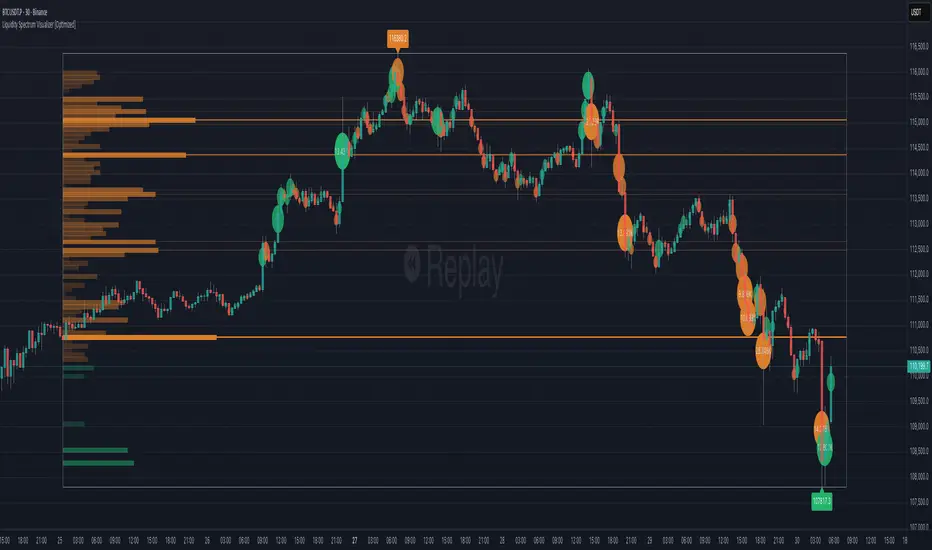OPEN-SOURCE SCRIPT
Liquidity Spectrum Visualizer BigBeluga - optimized by nguyenthl

This optimized version of the original Liquidity Spectrum Visualizer is designed for traders who want the same analytical output as the original indicator, but with significantly faster execution and smoother performance.
The script preserves the original visualization and logic — it still maps volume activity across price bins to highlight liquidity clusters — but the internal calculations have been carefully restructured to reduce computational load and improve responsiveness on live charts.
What’s new and why it matters
Single-pass binning algorithm: Each bar is processed once, reducing loop complexity from O(N×M) to O(N). This allows the indicator to run fluidly on higher timeframes and large datasets.
Precomputed min/max levels: Eliminates redundant array scans, improving efficiency for real-time analysis.
Minimal label usage: Only key high/low markers are drawn, removing visual clutter and improving chart readability.
Optimized resource handling: Boxes and lines are refreshed as a group, minimizing redraw lag.
Why this is useful
This version is particularly helpful for traders using complex layouts, slower machines, or multi-chart setups. It offers the same analytical insight into liquidity zones while keeping chart performance stable and responsive.
How to use it
Apply the indicator as you would the original version. It visualizes liquidity distributions, helping identify areas of concentrated activity or potential support/resistance zones.
The script includes optional features such as gradient rendering and POC (Point of Control) highlighting, which can be toggled on or off for clarity.
Notes
The purpose of this version is purely performance optimization — analytical integrity is fully preserved.
The chart example provided focuses solely on this indicator, with no additional overlays, so users can clearly see its visual output.
The script preserves the original visualization and logic — it still maps volume activity across price bins to highlight liquidity clusters — but the internal calculations have been carefully restructured to reduce computational load and improve responsiveness on live charts.
What’s new and why it matters
Single-pass binning algorithm: Each bar is processed once, reducing loop complexity from O(N×M) to O(N). This allows the indicator to run fluidly on higher timeframes and large datasets.
Precomputed min/max levels: Eliminates redundant array scans, improving efficiency for real-time analysis.
Minimal label usage: Only key high/low markers are drawn, removing visual clutter and improving chart readability.
Optimized resource handling: Boxes and lines are refreshed as a group, minimizing redraw lag.
Why this is useful
This version is particularly helpful for traders using complex layouts, slower machines, or multi-chart setups. It offers the same analytical insight into liquidity zones while keeping chart performance stable and responsive.
How to use it
Apply the indicator as you would the original version. It visualizes liquidity distributions, helping identify areas of concentrated activity or potential support/resistance zones.
The script includes optional features such as gradient rendering and POC (Point of Control) highlighting, which can be toggled on or off for clarity.
Notes
The purpose of this version is purely performance optimization — analytical integrity is fully preserved.
The chart example provided focuses solely on this indicator, with no additional overlays, so users can clearly see its visual output.
Open-source script
In true TradingView spirit, the creator of this script has made it open-source, so that traders can review and verify its functionality. Kudos to the author! While you can use it for free, remember that republishing the code is subject to our House Rules.
Contact me in PM or on Telegram: @nguyenthl
Disclaimer
The information and publications are not meant to be, and do not constitute, financial, investment, trading, or other types of advice or recommendations supplied or endorsed by TradingView. Read more in the Terms of Use.
Open-source script
In true TradingView spirit, the creator of this script has made it open-source, so that traders can review and verify its functionality. Kudos to the author! While you can use it for free, remember that republishing the code is subject to our House Rules.
Contact me in PM or on Telegram: @nguyenthl
Disclaimer
The information and publications are not meant to be, and do not constitute, financial, investment, trading, or other types of advice or recommendations supplied or endorsed by TradingView. Read more in the Terms of Use.